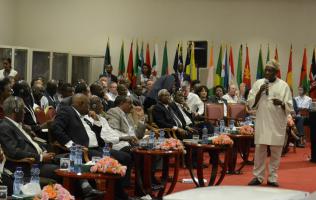African security remains a concern as the number of conflicts in Africa and intensity has increased in 2016 as compared to the previous year, said head of continental security forum.
“2016 was also a year of multiple riots, protests and socio-political anomies, with a 5% increase over the previous with outbreaks in Tunisia, South Africa, Ethiopia, Mali, Gabon, Cameroon, Chad and the Gambia, to mention a few,” said Olusegun Obasanjo, Former Nigerian President and Chairman of Tana High-Level Forum on Security in Africa.
“Sadly, those popular expressions witnessed where matched by the growing securitization of protests as many governments embarked on crackdowns, arbitrary arrests and detentions, shutdown of communication systems, to mention a few,” he said on Saturday in Bahir Dar City of Ethiopia at the opening of the 6th Tana High-Level Forum on Security in Africa.
In 2016, the overall number of conflict and violent events in Africa stood at 17,539; two more than in the previous year and their cumulative intensity and impacts remained dangerously high, according to Obasanjo.
He also noted that in 2016 Africa has witnessed an implosion in the number of non-state conflict agents such as militias, vigilantes, violent extremist groups and spontaneous movements (protesters) in relation to the intensity of violence they perpetrate.
Countries like Libya, Somalia, South Sudan and Nigeria that have experienced long-standing violent conflicts also recorded the highest number of conflict events. The four countries account for one-thirds of all violent conflict on the continent during the same year, slightly decreasing from 35% and 40% in 2015 and 2014, respectively.
In addition the numbers of so-called ‘low-intensity’ conflicts or ‘quasi-war’ situations increased as witnessed in Mozambique, Burundi, Cameroon, Nigeria, the DRC, Northern Mali, and those along border regions throughout the Sahel region where the writ of the state is minimal or non-existent.
“Unfortunately, due to scanty media coverage those equally deadly episodes of internecine violent rooted in unresolved or badly managed historical-political grievances mostly escaped public attention,” he said.
African migrants’ death
2016 witnessed the highest number of migrants’ death in the Mediterranean with the number of casualties and missing persons from the multitude seeking to cross into Europe through North Africa, especially from Libya, topping 5,098; or 35% above the 2015 levels. On average, to quote the UNHCR, 14 people die every single day in 2016 trying to cross the treacherous waters of the Mediterranean;
In 2016, the scale of human fatalities from multiple sources that included those from organised armed conflict events was estimated at 30,000, a decrease by 6,000 from the previous year’s levels. Even at that, civilians continued to be targeted or caught in crossfires to the extent that violence against civilians across the continent increased for the second year in a row to 45%, up by three percentage points from 2014 levels, according to the Chairman of Tana Forum, who made his statement entitle, “State of Peace and Security in Africa 2017 Little or No Change”.
This year the Forum focused on natural resources governance in Africa with emphasis on how the continent is handling its agricultural land, inland water, sea water, forest and biodiversity and mineral resources.
Africa is known for poverty though it has the world’s 12% oil reserve, 40% of global gold deposit and hundreds of precious minerals among others. Most of the conflicts and instabilities, which lead the continent to poverty, are often caused as a result of poor management of these natural resources. The Forum is has discussed these issues and is expected to recommend best practices out of the continent to the African countries.
YOU MAY WATCH THE OPENING FROM LAST YEAR / 2016 OPENING SESSION
[embedyt] https://www.youtube.com/watch?v=DCwxvc36q5g[/embedyt]

